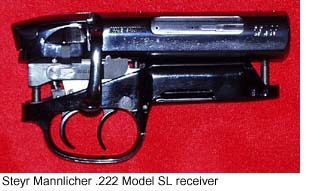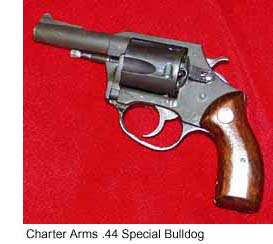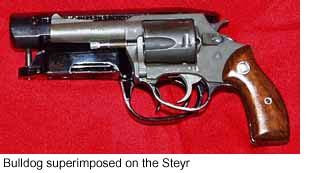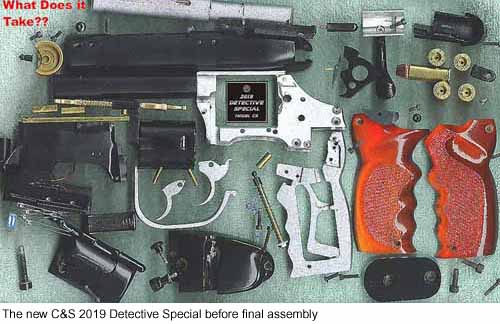Creating the 2019 Detective Special
by Phil Steinschneider
Introduction
In 1982, 18 years before this article was written and posted online, there was an ongoing debate and mystery surrounding what is probably one of the most beloved props ever created for a movie. To call the Blade Runner Blaster an enigma is almost an understatement. For many years, the origins of almost all the props in the science fiction classic Blade Runner were somewhat vague. Nevertheless, the flying police car known as the "Spinner" and the replicant-detecting "VK" or "Voight-Kompf" machine were relatively well documented in the available literature; as were many other props and special effects used in the film. When Paul M. Sammon's book, Future Noire: The Making of Blade Runner was published in 1996, then revised and expanded in 2007, most Blade Runner fan's dreams were answered—at least most of their dreams. Unfortunately, and probably due to the voluminous amounts of insider information available on Blade Runner, Mr. Sammon had to edit out or overlook one of the greatest prop riddles: How was the Blade Runner blaster made and who created it?
In July of 1998, after having brought upon myself the responsibility of getting to the bottom of the Blade Runner blaster origin challenge, I proceeded to collect as much information about the weapon as possible. The data stated clearly that the blaster was made from a Steyr Mannlicher .222 Model SL rifle. Based on this information, and the knowledge that the Steyr rifle had double-set triggers, I became convinced that the Blade Runner gun was made entirely from the Steyr and nothing else. I assumed that a grip had been fashioned and then welded onto the rifle frame for the outcome we see on the movie screen. It was not until I stumbled upon my old friend Richard Coyle's website at www.racprops.com, and his fascinating article on the Blade Runner blaster, that my pedestrian theories were set adrift. According to Richard, the blaster had a revolver in it. The pistol-in-the-Steyr theory was a radical concept to me. Not only did it seem unlikely, it appeared improbable. Regardless, I proceeded to search for the parts necessary to build my own "hero" version of the prop.
 After scouring gun magazines and gun trade journals, I finally found my quarry. A gentleman in Alabama was selling the exact Steyr I was looking for—granted, it had a broken stock, but I only wanted the receiver anyway—and it was available for only $450. Generally, good Steyr Model SL rifles sell for at least $1200. I called the seller, who had fortunately not yet found a buyer for the weapon, arranged for a transfer through my local gun dealer, and waited for the rifle to arrive. Once in my possession, it became clear to me that the barrel on the gun would have to be removed. Furthermore, I was at a loss as to how I would produce my "hero" gun. It was at this point that I remembered the article on Richard A. Coyle's website. Maybe Richard could make a reproduction of the gun? I contacted him with my idea and he responded to me with charm and enthusiasm. And so it began, Richard Coyle and I embarked on what had now become a two-man odyssey in search of the "true" Blade Runner blaster reproduction.
After scouring gun magazines and gun trade journals, I finally found my quarry. A gentleman in Alabama was selling the exact Steyr I was looking for—granted, it had a broken stock, but I only wanted the receiver anyway—and it was available for only $450. Generally, good Steyr Model SL rifles sell for at least $1200. I called the seller, who had fortunately not yet found a buyer for the weapon, arranged for a transfer through my local gun dealer, and waited for the rifle to arrive. Once in my possession, it became clear to me that the barrel on the gun would have to be removed. Furthermore, I was at a loss as to how I would produce my "hero" gun. It was at this point that I remembered the article on Richard A. Coyle's website. Maybe Richard could make a reproduction of the gun? I contacted him with my idea and he responded to me with charm and enthusiasm. And so it began, Richard Coyle and I embarked on what had now become a two-man odyssey in search of the "true" Blade Runner blaster reproduction.
The more I looked at my recent acquisition, the more I began to question the paradigm I had constructed around it. Was Richard Coyle right in believing there was a revolver inside the original screen-used prop? The theory that Richard had been preaching began to congeal. Based on the way the Steyr was made, which was now quite clear because I had one to use as a reference, it became obvious that the pistol-in-the-Steyr theory was correct. That revelation only brought more questions, however. What revolver would they have used under the Steyr receiver? At first, the J-frame Smith & Wesson revolvers seemed the most likely candidates. But the more we investigated, the more the Smith & Wessons could be ruled out. The distinctive cylinder release on the left side of the prop was the key. If we could identify a pistol with the same cylinder release, we would have our revolver. I rifled though hundreds of pages of gun publications to locate our most likely candidate. The only pistol with the cylinder release identical to the one in the dozens of movie screen captures I had made was the Charter Arms line of revolvers. But it was not until I went to my local gunsmith, Robert and Sandy Garrett of Northern Virginia Gun Works*, to pick up my now barrel-less Steyr, that the question was convincingly answered: According to Sandy Garrett, the gun in the Blade Runner blaster was most likely a Charter Arms .44 Special Police Bulldog. Empowered by that knowledge I set forth, searching for a Bulldog.
 Within a month, a friend who I had informed about our quest found what we were looking for. A Charter Arms Bulldog was being sold on consignment in a gun shop. The pistol was not in excellent shape, but it would serve our purposes. The price of $155 was acceptable, so I purchased the pistol.
Within a month, a friend who I had informed about our quest found what we were looking for. A Charter Arms Bulldog was being sold on consignment in a gun shop. The pistol was not in excellent shape, but it would serve our purposes. The price of $155 was acceptable, so I purchased the pistol.
Armed with all of the necessary source material: the Steyr rifle, a Charter Arms Bulldog, and a casting of the Blade Runner gun from a movie-used dummy, master propmaker Richard A. Coyle began the long arduous task of recreating the Blade Runner blaster.
Yet the search did not stop. Richard and I continued to look for additional and corroborating evidence. In an attempt to locate the credited Blade Runner property master, I called every Terry Lewis in California to no avail. We scoured through the movie, frame-by-frame, observing every detail and nuance, trying to discover some small element that we might have missed. And although we constantly added to our knowledge base, our fundamental premise remained sound; we were sure we had the details right.
It wasn't until we received a serendipitous email from a third Blade Runner blaster fanatic that all of our questions were answered. After almost ten months of analysis and study, our imaginations were no longer fresh. It was not until we entered into regular contact with the third musketeer of our Blade Runner blaster triumvirate that new discoveries and revelations began to manifest themselves. Craig Kovach was even more enamored of the Blade Runner blaster than we. It was his enthusiasm and passion that forced us to reinvestigate old leads. And it was he who contributed dozens of details that we had missed.
 One evening, while browsing Paul Sammon's "Future Noir" and rereading the film credits for the tenth time, I became struck by something that I had never noticed before: There was more than one property master in the Blade Runner credits. In fact, there were three assistants. One of them had a rather unusual name so I decided to search for him in the California white pages on the off chance that he might still live in the state, be listed in the phonebook, and be someone who would have information about the Blade Runner gun. In an incredible stroke of good luck, he was indeed there. Although I initially spoke with the gentlemen's son and left my number, within fifteen minutes, I received a return call from the man who had not only been a property master on the movie, but the one in charge of contracting for the construction of the blaster. Additionally, he was able to describe dozens of fascinating facts about the movie that are too lengthy to go into here, but will appear in a future article at the RACProps website. From my conversation with this gentleman, I was able to resolve dozens of questions about the blaster that had eluded us for almost a year. What color was the stunt dummy gun? How many stunt dummies were made for use in the movie? Who did the pyrotechnics? Nevertheless, the most critical question was still illusive: What revolver was used in the construction of the Blade Runner blaster? Unfortunately, the property master did not have the answer. He gave me the name of the man who knew, however, and I proceeded to contact him.
One evening, while browsing Paul Sammon's "Future Noir" and rereading the film credits for the tenth time, I became struck by something that I had never noticed before: There was more than one property master in the Blade Runner credits. In fact, there were three assistants. One of them had a rather unusual name so I decided to search for him in the California white pages on the off chance that he might still live in the state, be listed in the phonebook, and be someone who would have information about the Blade Runner gun. In an incredible stroke of good luck, he was indeed there. Although I initially spoke with the gentlemen's son and left my number, within fifteen minutes, I received a return call from the man who had not only been a property master on the movie, but the one in charge of contracting for the construction of the blaster. Additionally, he was able to describe dozens of fascinating facts about the movie that are too lengthy to go into here, but will appear in a future article at the RACProps website. From my conversation with this gentleman, I was able to resolve dozens of questions about the blaster that had eluded us for almost a year. What color was the stunt dummy gun? How many stunt dummies were made for use in the movie? Who did the pyrotechnics? Nevertheless, the most critical question was still illusive: What revolver was used in the construction of the Blade Runner blaster? Unfortunately, the property master did not have the answer. He gave me the name of the man who knew, however, and I proceeded to contact him.
With excitement and apprehension (we did not want to discover that a Smith & Wesson revolver had been used in the blaster) I called the man who had been commissioned by the creators of Blade Runner to manufacture the famous Blade Runner blaster. When he picked up the phone I introduced myself and explained that I was researching the making of the Blade Runner gun. At first, I asked if it would be okay for me to tell him what I believed about the firearm. He agreed. I explained what everyone already knows about the Steyr receiver, but then I proceeded to tell him that we were convinced that a revolver had been built in under the Steyr and that this gun was a Charter Arms Bulldog. A short silence ensued. I did not know if we were doomed or saved. The answer came: Yes, it was a Charter Arms .44 Special Police Bulldog. Eureka! Ten months of single-mindedness had paid off. We now had our answer.

* Sandy A. Garrett, Jr. and Robert H. Garrett
Northern Virginia Gun Works, Inc.
(703) 644-6504